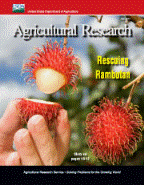United States Department of Agriculture: Agricultural Research Service, Lincoln, Nebraska

Agricultural Research Magazine
Date of this Version
8-2013
Document Type
Article
Citation
Agricultural Research 61(7): August 2013; ISSN 0002-161X
Abstract
Fresh, deliciously sweet navel oranges, on display at your local supermarket, may have been quickly inspected with ultraviolet (UV) light when they were still at the packinghouse. Usually, the purpose of this special sorting and screening is to see if circular spots—which glow a bright, fluorescent yellow and may be about the size of a quarter or larger—show up on the fruit’s peel.
More often than not, these spots, which scientists refer to as “lesions,” are telltale indicators of the presence of microbes that cause decay, namely Penicillium italicum, responsible for blue mold, or P. digitatum, the culprit behind green mold.
It isn’t the microbes that are fluorescing under the packinghouse UV lamps. Instead, it’s tangeritin, a natural compound in citrus peel oil. When the peel is damaged, such as by decay, tangeritin moves closer to the peel surface, or perhaps seeps out of it, becoming easier for UV to detect.
Included in
Agriculture Commons, Animal Sciences Commons, Food Science Commons, Plant Sciences Commons

